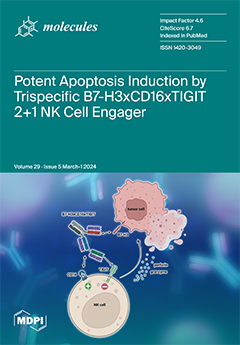Ardisia crenata Sims, an important ethnic medicine, is recorded in the
Chinese Pharmacopoeia for treating laryngeal diseases and upper respiratory tract infections. This study aimed to evaluate the antimicrobial effect of extracts and potential antimicrobial compounds of
A. crenata Sims. It was found that the roots of
A. crenata Sims have a potential inhibitory effect on
Candida albicans and
Aspergillus flavus, with MICs of 1.56 mg/mL and 0.39 mg/mL, and the leaves of
A. crenata Sims have a potential inhibitory effect on
Pseudomonas aeruginosa and
Staphylococcus aureus, with MICs of 3.12 mg/mL and 6.77 mg/mL, respectively. Meanwhile, five compounds including one catechin and four bergenins were obtained from roots. These components were identified on the fingerprint spectrum, representing chromatographic peaks 16, 21, 22, 23, and 25, respectively. Among these, 11-
β-
d-glucopyranosyl-bergenin and (−)-gallocatechin showed potential inhibition for
Staphylococcus aureus and
Pseudomonas aeruginosa with MIC of 0.26 and 0.33 mg/mL, respectively. The roots, stems, and leaves of
A. crenata Sims are very similar in chemical composition, with large differences in content. Principal component analysis (PCA) and Hierarchical cluster analysis (HCA) showed that 16 batches of
A.
crenata Sims could be divided into four main production areas: Guizhou, Jiangsu, Guangxi, and Jiangxi. Furthermore, molecular docking results showed that 11-
β-
d-glucopyranosyl-bergenin had a better affinity for Casein lytic proteinase P (ClpP), and (−)-gallocatechin possessed a strong affinity for LasA hydrolysis protease and LasB elastase. These findings suggest catechin and bergenins from
A. crenata Sims can be used as antimicrobial activity molecules.
Full article






